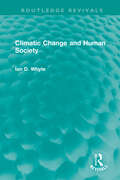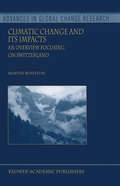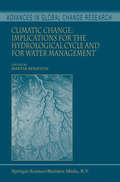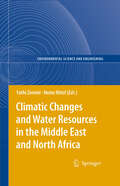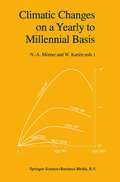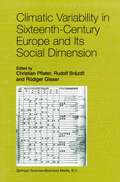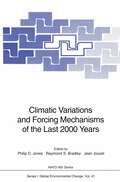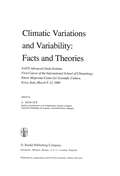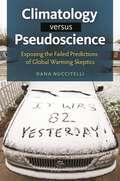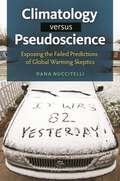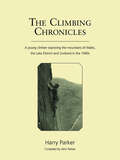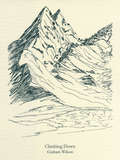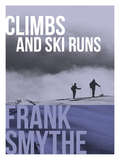- Table View
- List View
Climatic Change and Human Society (Routledge Revivals)
by Ian D. WhyteOriginally published in 1995, this book brings together material from many sources and offers a balanced appreciation of the ways in which climatic changes can interact with society. The questions it discusses are as relevant now as when the book was published: how far should governments go in taking expensive and unpopular measures to reduce greenhouse gas emissions? Will the warming trend produce results as dire as have been predicted? It does not presuppose a background in science and extensive use is made of case studies drawn from around the world to put scientific principles into context. An invaluable book for those approaching the subject for the first time.
Climatic Change and Its Impacts: An Overview Focusing on Switzerland (Advances in Global Change Research #19)
by Martin BenistonClimatic Change is a rapidly evolving domain that has prompted the publication of numerous scientific works in recent years, reflecting both the public and scientific interest in the topic. This book focuses upon climate processes, variability and change and applies the general principles related to these issues, particularly in Switzerland. Although a small country, Switzerland is characterized by complex topography where climatic processes are often enhanced due to the presence of the Alps. In addition, there is a remarkable density of observational data in both the natural and social sciences that enable a comprehensive assessment of climate processes, their long-term trends and their impacts. This book draws upon recent scientific work by the author, as well as by close colleagues working within scientific networks both in Switzerland and Europe, in order to provide the reader with up-to-date information on climate processes in the course of the 20th and 21st centuries. This book is intended for students from the undergraduate level onwards and researchers interested in climate issues specific to the alpine region.
Climatic Change at High Elevation Sites
by Henry F. Diaz Martin Beniston Raymond S. BradleyThis book provides a unique, in-depth view of past, present and potential future climatic change in mountain regions, and in particular on the mechanisms which are responsible for this change. Other books which focus on environmental change in mountains focus more generally on the impacts of this change on mountain systems, rather than on the regional features of climatic change itself. The book enters into a high level of detail concerning results of international investigations which involve specialists from numerous climate-related disciplines. The book can be used in an academic and research context, for advanced graduate and doctoral students, as well as researchers working in various domains of relevance to climatic change issues. The book also has relevance in the context of future activities of the Intergovernmental Panel on Climate Change (IPCC), in terms of providing up-to-date knowledge of fundamental mechanisms and consequences of climatic change in mountain regions.
Climatic Change: Implications for the Hydrological Cycle and for Water Management (Advances in Global Change Research #10)
by Martin Benistonyear simulations in order to separate noise in the system from the climate change signal. Several contributing papers focused on case studies using Regional Climate Models (RCMs) linked to hydrological models, applied to the analysis of runoff under conditions of convective activity and extreme precipitation, in regions of complex topography, or stakeholder-driven investigations such as water runoff simulations in Quebec undertaken for a major utility. Thorough analyses of GCM results for the Century were reported at the Workshop, in order to illustrate the improvements in model results which have taken place in recent years, and the increasing confidence with which the models can be used for projecting climatic change in coming decades. However, there is still much room for improvement; there is also a need to address more fully the manner in which climate and impacts models (e. g. , hydrological models) can be linked, in terms of consistency and the overlap between different scales, the underlying physical assumptions, and the parameterizations used. Session 2 was devoted to the two extremes of water resources, namely floods and droughts, the focus here being to identify the climate change component in river floods. These have significant economic implications, as was shown by several scientists from Western and Central Europe. Many long time series have been studied worldwide with the aim of detection of nonstationarities, yet there is no conclusive evidence of climate-related changes in flow records, in general.
Climatic Changes and Water Resources in the Middle East and North Africa (Environmental Science and Engineering)
by Fathi Zereini Heinz Hötzl"Climatic Change and Water Resources in the Middle East and North Africa" is dedicated to high-priority topics related to the impact of climate change on water resources in a water scarce region. The subject is described and discussed in three main chapters and different case studies. The three main chapters are (1) Climatic changes - sources and effects on the water cycle, (2) Impact of climate change on water resources, (3) Water resources and water management. These chapters are split up into further 26 sections. A total of 64 individuals from many countries have made contributions to this book. All topics in this book are complimentary and contribute to a comprehensive understanding of the interactions between global climate change, world water cycle and water resources. A valuable and meaningful interdisciplinary mixture of topics is combined in this book which will be of great interest to many scientists.
Climatic Changes on a Yearly to Millennial Basis: Geological, Historical and Instrumental Records
by N. A. Mörner W. KarlénNils-Axel Marner &Wibjarn Karlen Organizers of the Stockholm Symposium in 1983 Stockholm University, Sweden This book is the Proceedings of the SECOND NORDIC SYMPOSIUM ON CLIMATIC CHANGES AND RELATED PROBLEMS held in Stockholm, Sweden, May 16-20, 1983 (Frydendahl et al., 1983; Marner, 1983). This was "an international interdisciplinary symposium with special refe rence to Nordic records and their relation to global climatic changes". The first NORDIC SYMPOSIUM ON CLIMATIC CHANGES AND RELATED PROBLEMS was held in Copenhagen in 1978 ( Frydendahl, 1978) and had a very broad scientific program. The SECOND NORDIC SYMPOSIUM was specifically directed to certain problems, time ranges and sources of information, as discussed below. Scandinavia is a classical area for the study of climatic fluctuations during the last 20,000 years . A major part of the basic data for the international theories and synthesis originate from Scandinavian data. This applies, for example, to: (1) The drastic climatic fluctuations in connection with the re cession of the land-ice giving rise to the alternation of inter stadials (warm periods with rapid ice recession) and stadials (cold periods with readvances or retardations in the ice recession). (2) The climatic changes during the Holocene with its well-known sub-division according to the Blytt-Sernander system (nowadays being used far outside the boreal region for which it was origi nally defined). (3) The Holocene climatic optimum and the subsequent climatic de terioration at around 2500 BP (well-established already at the beginning of this century).
Climatic Changes Since 1700 (Advances in Global Change Research #55)
by Stefan BrönnimannThe proposed book is not only a tribute to the work of Brückner (and indeed also a personal tribute, since Brückner wrote his book at the Institute of Geography of the University of Bern), but references to Brückner’s book are also a conceptual tool in the proposed book, though used sparingly and thoughtfully. Apart from providing historical context, references may facilitate introducing some complex topics, for instance by first presenting Brückner’s view and then complementing the picture with today’s understanding. References can be used for contrast: Comparing Brückner’s methods and data with today’s research concepts makes the progress in the field easily understandable. The enormous growth of information since Brükner’s time allows a much more detailed perspective on some scientific problems. Or references can be used to highlight similarity. Some aspects have not changed over time. Finally, the book complements Brückner’s studies by adding the arguably most interesting and certainly most relevant period, the past 120 years.
Climatic Impact of Activities: Methodological Guide for Analysis and Action
by Jean-Yves RossignolWhere the environment is concerned, regardless of scale, the logic of the Native American hummingbird which "does its part" should prevail. To act independently of others is indeed the sine qua non of the global shift towards a regenerative economy of humanity and ecosystems, expurgating the pervading pollution (particularly from oil use). Small- and medium-sized enterprises, which this book especially targets, do not need disproportionately-sized study facilities in order to reduce their impact on global warming. Climatic Impact of Activities provides valuable methodological and practical support for establishing a complete and reliable diagnosis of the greenhouse effect, and for planning the corresponding corrective actions. This book guides the reader step by step in developing an informed emissions assessment with realistic and advanced case studies, in full compliance with official methodological recommendations.
Climatic Impact of Activities: Methodological Guide for Analysis and Action
by Jean-Yves RossignolWhere the environment is concerned, regardless of scale, the logic of the Native American hummingbird which "does its part" should prevail. To act independently of others is indeed the sine qua non of the global shift towards a regenerative economy of humanity and ecosystems, expurgating the pervading pollution (particularly from oil use). Small- and medium-sized enterprises, which this book especially targets, do not need disproportionately-sized study facilities in order to reduce their impact on global warming. Climatic Impact of Activities provides valuable methodological and practical support for establishing a complete and reliable diagnosis of the greenhouse effect, and for planning the corresponding corrective actions. This book guides the reader step by step in developing an informed emissions assessment with realistic and advanced case studies, in full compliance with official methodological recommendations.
Climatic Variability in Sixteenth-Century Europe and Its Social Dimension
by RüdigerGlaser RudolfBrázdil ChristianPfisterA multidecadal cooling is known to have occurred in Europe in the final decades of the sixteenth-century. It is still open to debate as to what might have caused the underlying shifts in atmospheric circulation and how these changes affected societies. This book is the fruit of interdisciplinary cooperation among 37 scientists including climatologists, hydrologists, glaciologists, dendroclimatologists, and economic and cultural historians. The known documentary climatic evidence from six European countries is compared to results of tree-ring studies. Seasonal temperature and precipitation are estimated from this data and monthly mean surface pressure patterns in the European area are reconstructed for outstanding anomalies. Results are compared to fluctuations of Alpine glaciers and to changes in the frequency of severe floods and coastal storms. Moreover, the impact of climate change on grain prices and wine production is assessed. Finally, it is convincingly argued that witches at that time were burnt as scapegoats for climatic change.
Climatic Variations and Forcing Mechanisms of the Last 2000 Years (Nato ASI Subseries I: #41)
by Philip Douglas Jones Raymond Stephen Bradley Jean JouzelA profound knowledge of the past climate is vital for our understanding of global warming. The past 2000 years are both the period which is of most relevance to the next century and that for which there is the most evidence. High-resolution proxy records for this period are available from a variety of sources. Five sections consider dendroclimatology, ice cores, corals, historical records, lake varves, and other indicators. The final two sections cover the histories of various forcing factors and attempt to bring together records from a variety of sources and provide explanations.
Climatic Variations and Variability: NATO Advanced Study Institute First Course of the International School of Climatology, Ettore Majorana Center for Scientific Culture, Erice, Italy, March 9–21, 1980 (Nato Science Series C: #72)
by A. L. BergerGENERAL INTRODUCTION TO THE ETTORE MAJORANA INTERNATIONAL SCHOOL OF CLIMATOLOGY The "Ettore Majorana Centre" for Scientific Culture, founded at Erice in 1963 by prof. Nino Zichichi, pursues the fundamental aim to create in Europe a cultural forum of high scientific standard, which can allow young research workers to appreciate current problems of major interest in the various fields of scientific research. , Since the beginning, its International Schools (over 70, today) have actively worked in disseminating scientific culture produced at the most advanced frontiers of human knowledge, spanning varied domains from biology to nuclear physics, earth sciences, meteorology, architecture, medical sciences and so on, Recently, in 1979, the International School of Climatology has been created with the purpose to organize post-doctorate cour ,;es, in which outstanding and up-to-date outlooks, theories and results in the climatic field must be presented in didactic form. Climatic variability was the subject of the first Course, in that climatic changes represent one of the most exciting phenomenologies to study; in fact, even if the climate has changed many times in the past, so making it reasonable to as sume that it will do so in the future, it is still not easy to understand the above mentioned changes from an hydrodynamical point of view.
Climatic variations in historic and prehistoric time
by Otto PetterssonDieser Buchtitel ist Teil des Digitalisierungsprojekts Springer Book Archives mit Publikationen, die seit den Anfängen des Verlags von 1842 erschienen sind. Der Verlag stellt mit diesem Archiv Quellen für die historische wie auch die disziplingeschichtliche Forschung zur Verfügung, die jeweils im historischen Kontext betrachtet werden müssen. Dieser Titel erschien in der Zeit vor 1945 und wird daher in seiner zeittypischen politisch-ideologischen Ausrichtung vom Verlag nicht beworben.
Climatological Study of Urban Climate and Heat and Cold Mortalities in Japan (International Perspectives in Geography #21)
by Fumiaki FujibeThis book describes observed features of urban climate and its long-term variations as well as the relationship of climate to heat stroke in Japan, based on observational data and statistical analyses. Consisting of three parts, the book is a valuable resource for researchers and professionals involved with these topics. Part 1 focuses on urban climate. The basic characteristics of heat islands are reviewed, and long-term urban warming is described with a focus on the distinction from global warming. The influence of microscale environmental changes on the observed temperature is also presented, as well as changes in wind and precipitation in urban areas. They deepen our understanding of the features and mechanisms of urban heat islands and their long-term changes. Part 2 describes the climatological features of heat stroke mortality, which has become a major social problem in Japan, using mortality statistics and meteorological data. The spatial and temporal variations of heat stroke mortality are analyzed quantitatively on various spatial and temporal scales. In addition, the number of ambulance transports is examined as another measure of heat stroke casualty. The results provide insight into the climatological factors related to heat stroke mortality and contribute to the implementation of preventive measures. The climatology of deaths from extreme cold is also presented. For supplementary information, an overview of the geography, climate, and meteorological data of Japan is presented in Part 3.
Climatology from Satellites
by Eric BarrettOriginally published in 1974, was a pioneering study which summarized, within the pre-existing framework of atmospheric knowledge, the more significant findings that emerged from the first decade of climatological analyses of meteorological satellite data. It shows how these data complement and extend the traditional coverage of climatology. The book draws together in one volume research findings which were not previously available in book form and which significantly improve the understanding of climate, especially in regions that were conventionally data-remote.
Climatology from Satellites
by Eric BarrettOriginally published in 1974, was a pioneering study which summarized, within the pre-existing framework of atmospheric knowledge, the more significant findings that emerged from the first decade of climatological analyses of meteorological satellite data. It shows how these data complement and extend the traditional coverage of climatology. The book draws together in one volume research findings which were not previously available in book form and which significantly improve the understanding of climate, especially in regions that were conventionally data-remote.
Climatology in Cold Regions
by Chenghai WangClimatology in Cold Regions A groundbreaking interdisciplinary study of cold-region weather systems and their vital role in predicting climate change across the globe Climatology in Cold Regions explores the complexities of land−atmospheric interaction across the Earth’s cryosphere, systematically placing soil thawing, snow melting, surface diabatic heating, and other processes within the context of broader climatological models. Drawing from a wealth of new data, leading atmospheric scientist Chenghai Wang illustrates how cold-region weather systems can be parameterized to improve seasonal climate prediction and provide crucial insights into projected changes in climate over the next 50-100 years. The book opens with an introduction to the characteristics and classification of cold-region climatology, followed by a detailed description of the primary weather systems and land surface processes in cold regions. The core of the book presents a new approach for seasonal climate prediction using signals obtained from cryospheric processes, supported by a discussion of climate disasters and the impact of climate change on the ecology of cold regions. Introduces a new way of modeling climate in cold regions Offers novel approaches for assessing climate signals from cold regions in seasonal and sub-seasonal predictions Presents new data on the role of cold-region climatology in forecasting and driving global temperature changes Discusses the role of cold regions as the main source of global freshwater supply A significant contribution to climate research and beyond, Climatology in Cold Regions is essential reading for students, scientists, and researchers in the atmospheric sciences, meteorology, ecology, hydrology, and Earth sciences.
Climatology in Cold Regions
by Chenghai WangClimatology in Cold Regions A groundbreaking interdisciplinary study of cold-region weather systems and their vital role in predicting climate change across the globe Climatology in Cold Regions explores the complexities of land−atmospheric interaction across the Earth’s cryosphere, systematically placing soil thawing, snow melting, surface diabatic heating, and other processes within the context of broader climatological models. Drawing from a wealth of new data, leading atmospheric scientist Chenghai Wang illustrates how cold-region weather systems can be parameterized to improve seasonal climate prediction and provide crucial insights into projected changes in climate over the next 50-100 years. The book opens with an introduction to the characteristics and classification of cold-region climatology, followed by a detailed description of the primary weather systems and land surface processes in cold regions. The core of the book presents a new approach for seasonal climate prediction using signals obtained from cryospheric processes, supported by a discussion of climate disasters and the impact of climate change on the ecology of cold regions. Introduces a new way of modeling climate in cold regions Offers novel approaches for assessing climate signals from cold regions in seasonal and sub-seasonal predictions Presents new data on the role of cold-region climatology in forecasting and driving global temperature changes Discusses the role of cold regions as the main source of global freshwater supply A significant contribution to climate research and beyond, Climatology in Cold Regions is essential reading for students, scientists, and researchers in the atmospheric sciences, meteorology, ecology, hydrology, and Earth sciences.
The Climatology of Air-Mass and Frontal Extreme Precipitation: Study of meteorological data in Europe (Springer Atmospheric Sciences)
by Ewa ŁupikaszaBased on a data series of more than 50 years, this book discusses spatial and seasonal variability in air-mass and frontal extreme precipitation frequency and as well as the relationship between their occurrence and atmospheric circulation. The climatology of air-mass and frontal extreme precipitation is presented for the first time on a European scale. Since there is no robust, automatic method of locating atmospheric fronts, this challenging task has to be performed manually. Moreover, there is limited availability of the complex sub-daily data that is necessary to recognize the dynamic of meteorological fronts. The results show a clear regional and seasonal variety in the relationship between extreme precipitation occurrence and atmospheric circulation depending on precipitation origin. The probability of air-mass and frontal precipitation occurrence provides crucial information for studies in predictability and modeling. This book is intended for students, specialists in the field of climatology and climate change, climate process modelers, and other experts for whom extreme precipitation is important.x
Climatology versus Pseudoscience: Exposing the Failed Predictions of Global Warming Skeptics
by Dana NuccitelliThis book explains the science of climate change in plain language and shows that the 2 to 4 percent of climate scientists who are skeptical that humans are the main cause of global warming are a fringe minority—and have a well-established history of being wrong.Although some politicians, pundits, and members of the public do not believe it, global warming predictions by mainstream climate scientists have been remarkably accurate while those made by climate deniers have not. And if mainstream global warming predictions continue to prove correct, the window of opportunity to prevent a climate catastrophe is quickly closing. This book is the first to illustrate the accuracy—and inaccuracy—of global warming predictions made by mainstream climate scientists and by climate contrarians from the 1970s to the present day. Written in simple, non-technical language that provides an accessible explanation of key climate science concepts, the book will appeal to general audiences without previous knowledge about climate science.Author Dana Nuccitelli, an environmental scientist and risk assessor, discusses some key climate discoveries dating back to the 19th century and debunks myths such as the idea that climate scientists and climate models have grossly over-predicted global warming. He addresses recent findings of a 97-percent consensus in the peer-reviewed scientific literature that humans are causing global warming—a nearly unanimous agreement that formed in the early 1990s and has grown through the present day. Nuccitelli also discusses what the future climate might look like if current trends continue unabated, and what we as a global society need to do to prevent a climate catastrophe.
Climatology versus Pseudoscience: Exposing the Failed Predictions of Global Warming Skeptics
by Dana NuccitelliThis book explains the science of climate change in plain language and shows that the 2 to 4 percent of climate scientists who are skeptical that humans are the main cause of global warming are a fringe minority—and have a well-established history of being wrong.Although some politicians, pundits, and members of the public do not believe it, global warming predictions by mainstream climate scientists have been remarkably accurate while those made by climate deniers have not. And if mainstream global warming predictions continue to prove correct, the window of opportunity to prevent a climate catastrophe is quickly closing. This book is the first to illustrate the accuracy—and inaccuracy—of global warming predictions made by mainstream climate scientists and by climate contrarians from the 1970s to the present day. Written in simple, non-technical language that provides an accessible explanation of key climate science concepts, the book will appeal to general audiences without previous knowledge about climate science.Author Dana Nuccitelli, an environmental scientist and risk assessor, discusses some key climate discoveries dating back to the 19th century and debunks myths such as the idea that climate scientists and climate models have grossly over-predicted global warming. He addresses recent findings of a 97-percent consensus in the peer-reviewed scientific literature that humans are causing global warming—a nearly unanimous agreement that formed in the early 1990s and has grown through the present day. Nuccitelli also discusses what the future climate might look like if current trends continue unabated, and what we as a global society need to do to prevent a climate catastrophe.
The Climbing Chronicles: A young climber exploring the mountains of Wales, the Lake District and Scotland in the 1940s
by John ParkerThe Climbing Chronicles record the 1940s climbing exploits of Harry Parker. Born in Blackburn on 29 February 1916, Harry started climbing before the war and continued to do so after its conclusion, exploring the Peak District, Wales, the Lake District and Scotland. Each night he noted down his adventures in his 'chronicles', recording the routes he climbed, the walks, bicycle rides and journeys he undertook, and the people he met along the way. Harry's remarkable diaries have now been transcribed by his son John, and the resulting Chronicles offer a first-hand view of climbing and walking in Britain in the 1940s. With an enthusiasm for the outdoors and a sense of fun that springs from every entry, The Climbing Chronicles is an entertaining and fascinating - not to mention quirky - read.
Climbing Down: Long distance walks in the Scottish, Welsh and English hills in manageable chunks
by Graham WilsonGraham Wilson's Climbing Down, selected as a Travel Book of the Week in The Guardian, features long distance walks in the Scottish, Welsh and English hills — but in manageable chunks. Wilson makes an entertaining companion; once he was fit enough for the Bob Graham Round, now he's the victim of a crumbling hip. So, he breaks the walks into sections and, instead of calling on a shuttle-service of friends with cars, takes to public transport. The walks include an Alternative Snowdon Horseshoe, a Scottish Coast to Coast and the Yorkshire Centurion, as well as several Peak District rounds. And a new, gentler activity is proposed for the compulsive list-ticker: island-bagging. Wilson's experiences are recounted in his own inimitable style, with the usual eccentric digressions into topi such as coffin roads and cut-hopping, Munros and mobile phones, solo climbing and slippered pigs. Wonderfully illustrated with drawings by Gerry Dale.
Climbs and Ski Runs
by Frank Smythe"Why do you climb?" The mountaineer has no answer to this question. The best things in the world cannot adequately be expressed in speech or print; they are part of the soul.' In Climbs and Ski Runs, Frank Smythe takes the reader on Alpine ski trips and Dolomite adventures, up first ascents in North Wales and on to the mighty Brenva Face of Mont Blanc. He places pebbles for runners, 'shoots' crevasses and is struck by lightning. And yet, all the while, he perfectly captures the moments that make climbing and mountaineering so special - moments that will resonate with anybody who has spent time in the hills. Frank Smythe was among the leading mountaineers of the early twentieth century and one of the finest climbing writers ever to put pen to paper. In Climbs and Ski Runs he documents his early forays into the mountains, giving a remarkable insight into that period of climbing and mountaineering. Yet it is not this that makes the book special. It is Smythe's ability to observe and recreate his surroundings and to write so compellingly about the climber's response to them, and to the moments of difficulty and danger, that brings Climbs and Ski Runs to life.
